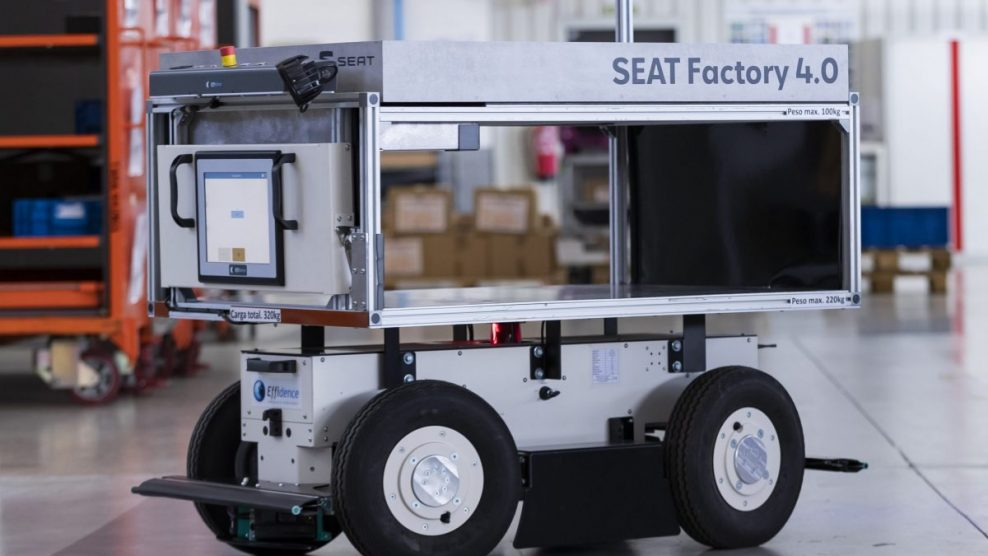In the digital era, the automotive industry is evolving rapidly, and SEAT, one of Europe’s leading manufacturers, is at the forefront of this transformation. Logistics 4.0 has revolutionised SEAT’s supply chain, integrating advanced technologies to optimise efficiency, agility and quality throughout the process. In this article, we explore how SEAT has implemented Logistics 4.0, and how it is redefining the landscape of the automotive industry.
Seat has recently incorporated two autonomous robots at its Martorell plant (Barcelona) to help operators in tasks such as transporting heavy loads. EffiBOT aims to adapt to production processes and manage resources and communication between the different areas of the company more efficiently. “Autonomous mobile robots put us at the forefront of innovation in the automotive sector,” said Seat’s Vice President for Production and Logistics, Herbert Steiner.
The robots, which can transport all kinds of materials required for the assembly of cars weighing up to 250 kilograms in load and 500 kilograms in haulage, have been incorporated in an experimental phase. In this connection, Seat has announced that the number of robots could be increased in the future. Unlike automated guided vehicles (AGVs), which require a track to operate, autonomous mobile robots (AMR) such as EffiBOT can recognise their surroundings to establish their own route to a defined point and avoid obstacles. It is worth noting that Seat currently has around 20 collaborative robots in assembly areas. It also has AGVs in indoor and outdoor areas and drones, which it combines with the use of artificial intelligence, big data and blockchain for data management.
But first of all, what does Logistics 4.0 mean?
Logistics 4.0 is a new era of logistics management, driven by digitalisation and automation. It combines technologies such as the Internet of Things (IoT), artificial intelligence (AI), machine learning and data analytics to improve efficiency and visibility throughout the supply chain. Logistics 4.0 enables more accurate decision-making, greater flexibility and faster delivery of products.
How is SEAT implementing it?
Supply chain optimisation: SEAT has implemented advanced data-driven supply chain management solutions, allowing them to have real-time visibility of logistics processes. This helps to optimise planning, tracking and inventory management, reducing lead times and operational costs.
Smart warehouses: SEAT’s warehouses have adopted cutting-edge technologies such as radio frequency identification (RFID) and robotic automation systems. These technologies improve accuracy and speed in inventory management, picking and packing, reducing errors and streamlining processes.
Intelligent transport: SEAT has implemented IoT-based tracking and monitoring systems in its transport fleet. These systems enable real-time tracking of vehicles and route optimisation, improving on-time deliveries and reducing transport costs.
Digital collaboration: SEAT has established a digital platform that connects all partners in its supply chain, from suppliers to distributors. This platform facilitates real-time collaboration, transparent communication and information sharing, improving coordination and efficiency throughout the logistics network.
What does SEAT gain from this type of logistics?
-Increased efficiency and productivity in the supply chain.
-Improved quality and error reduction.
-Greater visibility and real-time monitoring of logistics processes.
-Greater agility and flexibility to adapt to changes in market demand.
So in conclusion, Logistics 4.0 has transformed SEAT’s supply chain, enabling them to reach new levels of efficiency, agility and quality. Through digitalisation and automation, SEAT has optimised its logistics processes, from inventory management to transport and collaboration with its partners. As a leader in the automotive industry, SEAT is at the forefront of Logistics 4.0, redefining the standard of excellence in logistics management. Logistics 4.0 has become a key pillar for SEAT’s success and competitiveness in a constantly evolving business environment.
